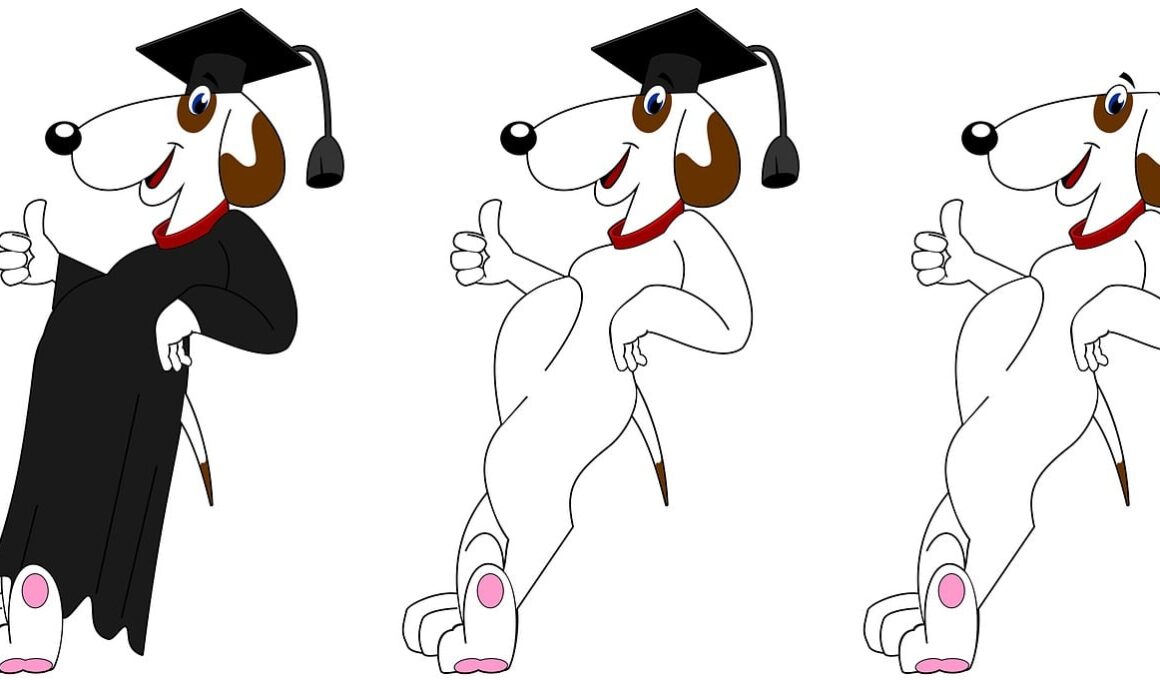Using Food Motivation Responsibly in Dog Training
Positive reinforcement is a widely applied method in dog training that utilizes rewards, particularly food, to encourage desired behaviors. This technique enhances learning and builds a trusting bond between you and your canine companion. Dogs naturally respond well to food, making it an effective motivator during training sessions. However, using food responsibly is crucial for your pet’s well-being and your training success. Over-reliance on treats can lead to obesity and behavioral issues. Always aim to use healthy, low-calorie treats that keep your dog in shape. Morsels of cooked chicken or small bits of kibble can be great options. Timing plays a vital role; give a treat immediately after your dog performs a desired action to reinforce the behavior. Additionally, varying the types of food rewards can maintain your dog’s interest. Consistent training sessions that incorporate food motivation should be balanced with praise and affection, ensuring a rounded experience for your pet. As you work towards specific commands or tricks, be mindful of the quantity of food given and adjust your dog’s regular meals accordingly to prevent overfeeding. Effective training methods enhance your relationship with your dog.
A clear training plan incorporates food motivation in a gradual manner. Start with high-value treats when teaching new commands; these are often more enticing than regular kibble. Once your dog learns the command, you can gradually reduce the frequency of treats while replacing them with verbal praises or petting. This transition helps your dog understand that while treats are good, your verbal cues are also highly rewarding. Mixing primary and conditioned reinforcers can keep your canine friend engaged during training. For example, alternate between various treats and verbal praise to maintain excitement. When using food, keep the training environment distraction-free initially; this ensures your dog focuses on learning without external interruptions. As they master commands, you can gradually introduce distractions to improve their focus. Always observe your dog’s body language to gauge their comfort and interest levels. Adjust your approach if you notice signs of disinterest or distress. Training should be a positive experience that fosters enjoyment for both you and your dog, enhancing cooperation and enthusiasm in future sessions. This mutual understanding will strengthen your training success and overall relationship.
Recognizing Your Dog’s Needs
Understanding your dog’s unique temperament and needs is essential when implementing food motivation in training. Each dog responds differently to various types of rewards based on their personal preferences, past experiences, and inherent behavior characteristics. Some breeds may be highly food-motivated, while others may require different incentives like toys or playtime. It’s important to experiment with various treats to see which ones excite your dog the most. Consider their individual dietary needs and any allergies when choosing treats. For dogs with specific health conditions, consult with a veterinarian to find suitable options that align with their dietary restrictions. Similarly, use smaller portions of high-value treats that won’t disrupt their meal plan. Building a solid training foundation requires patience and observation. Recognizing when your dog shows eagerness to engage or when they appear bored can significantly influence training strategies. Tailoring your rewards to fit your dog’s preferences can make sessions more effective. Take note of what motivates them best, as this will guide you in developing a constructive and enjoyable training routine. Ultimately, the goal is a happy, healthy dog that thrives on learning and participation.
Food motivation should always be used alongside other forms of reinforcement to create a balanced approach. Providing a variety of rewards will not only keep your dog engaged but will also reinforce the connection you share. For instance, combine food with physical rewards such as toys or games that your dog loves. This can help ensure that the focus of training sessions remains on positive interactions while learning. Simultaneously, the approach reinforces your dog’s bond with you. Remember that training is as much about building trust and a strong relationship as it is about teaching commands. Avoid using food as a bribe—make sure your dog sees it as a reward for good behavior. This perspective creates a positive association with your training sessions. Occasionally, it’s also beneficial to have training sessions without food altogether, rewarding with love and attention instead. This will teach your dog that your approval and affection are just as valuable as food, fostering a deepened bond. Practicing this balance helps them understand the importance of various rewards. In the end, the focus should always be on enhancing the enjoyment factor for both you and your beloved canine companion.
Managing Treat Portions
When incorporating food rewards into training, managing portion sizes is vital to your dog’s health. Excessive treat consumption can quickly lead to weight gain and obesity, as mentioned earlier. It’s essential to measure out rewards and understand their impact on daily caloric intake. A general guideline is to ensure treats make up no more than 10% of your dog’s daily food intake. Adjust your dog’s regular meals when using treats frequently to maintain a healthy balance. You can achieve this by reducing their meal portions accordingly. Regular exercise should also be emphasized as part of a healthy lifestyle accompanying training. Engage in daily walks or playtime to help burn off the calories consumed through treats. Keeping an eye on your dog’s weight can help you reassess treat sizes and their overall food consumption. Regular vet check-ups will also enable you to address any weight concerns and adjust accordingly. Maintaining your dog’s health through balance in their diet and exercise will ensure successful training sessions without compromising their physical well-being. Keeping your dog fit, happy, and healthy will enhance the effectiveness of all training methods you choose to adopt.
Consistency and repetition are key elements in successful dog training, especially when utilizing food motivation. Ensure that you always reward the same behavior each time it’s performed, reinforcing the connection between the action and the reward. Lack of consistency can confuse your dog, making it unclear what they’re being rewarded for. Establish a defined cue for different commands and be clear about your expectations. In time, your dog will associate certain actions with the desired outcomes when you consistently use food motivation. Aim to practice commands in various environments to help your dog generalize their understanding of the commands outside of the training context. Combine this practice with thoughtful use of food rewards. For example, once they perform a trick successfully at home, take the training outdoors where distractions are prevalent. Gradually increasing challenges will help your dog become a well-rounded and well-behaved companion. Training sessions should be kept short and enjoyable, ideally lasting no longer than 10 to 15 minutes. This limits frustration and fatigue, keeping your dog motivated and eager for the next session, allowing positive reinforcement to take root effectively.
Customizing Your Approach
Eliminating the typical pitfalls of food motivation in dog training involves customizing your approach based on observation. Every dog is different; while some will respond enthusiastically to food, others may not show interest at all. Identify your dog’s intrinsic motivators—what truly excites them beyond simple food rewards. Utilize those insights to create a customized training plan that appeals specifically to their preferences. For example, if a tug toy holds more value than treats, integrate that into your training sessions for better results. The goal should always be to foster an environment where learning is fun and rewarding for your dog. Creating a positive training atmosphere encourages them to engage with enthusiasm. Frequent variation in the types of rewards can minimize predictability, keeping your dog guessing and alert. This anticipation can enhance their eagerness to participate. Your role is to observe, adapt and modify your training strategies according to your dog’s response while using food as a significant aspect of their learning journey. This fluid approach will help them achieve their potential while fostering a strong bond between the two of you, paving the way for continued learning and growth.
In conclusion, responsible use of food motivation during dog training is an effective strategy when executed properly. It fosters enthusiasm and keeps the training process enjoyable for both you and your dog. However, always keep health and well-being at the forefront of your mind. Monitor portion sizes and ensure you engage your dog in various forms of mental and physical activities beyond training sessions. Balancing food rewards with affection can strengthen the bond you share and reinforce learned behaviors. Positive reinforcement, combined with strategies to maintain your dog’s health, will lead to a fulfilling and successful training experience. Remember to observe your dog’s responses, adapting your plan to their unique preferences. The art of training is not solely about commands but about creating a harmonious relationship that thrives on mutual respect and understanding. Strive to create a playful and engaging training environment that invites your dog to learn while enjoying the process. Ultimately, the true measure of successful training lies in a healthy, happy companion who is eager to learn and please you. Investing time in thoughtful training will yield long-lasting rewards in your dog’s behavior and your companionship.


